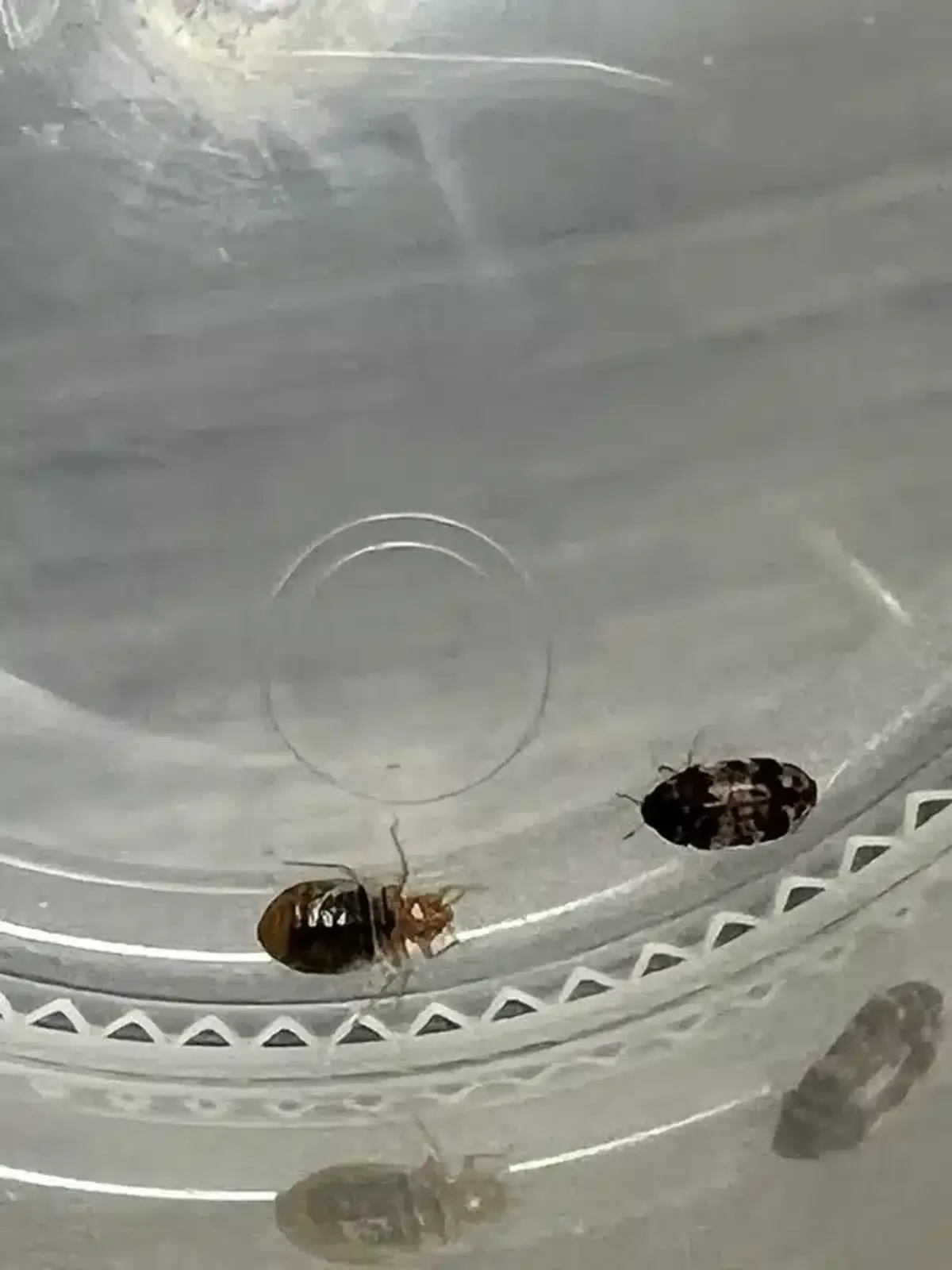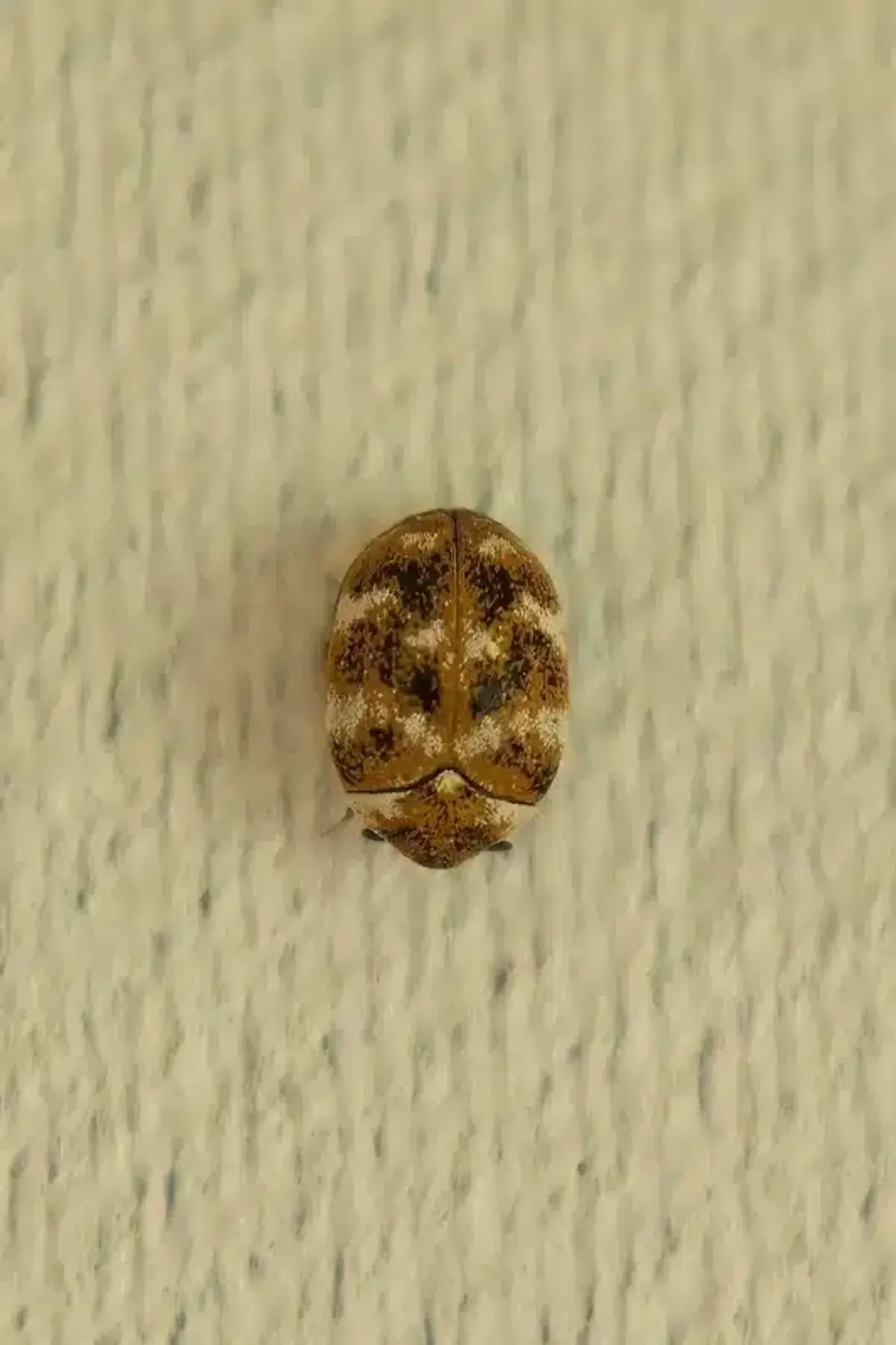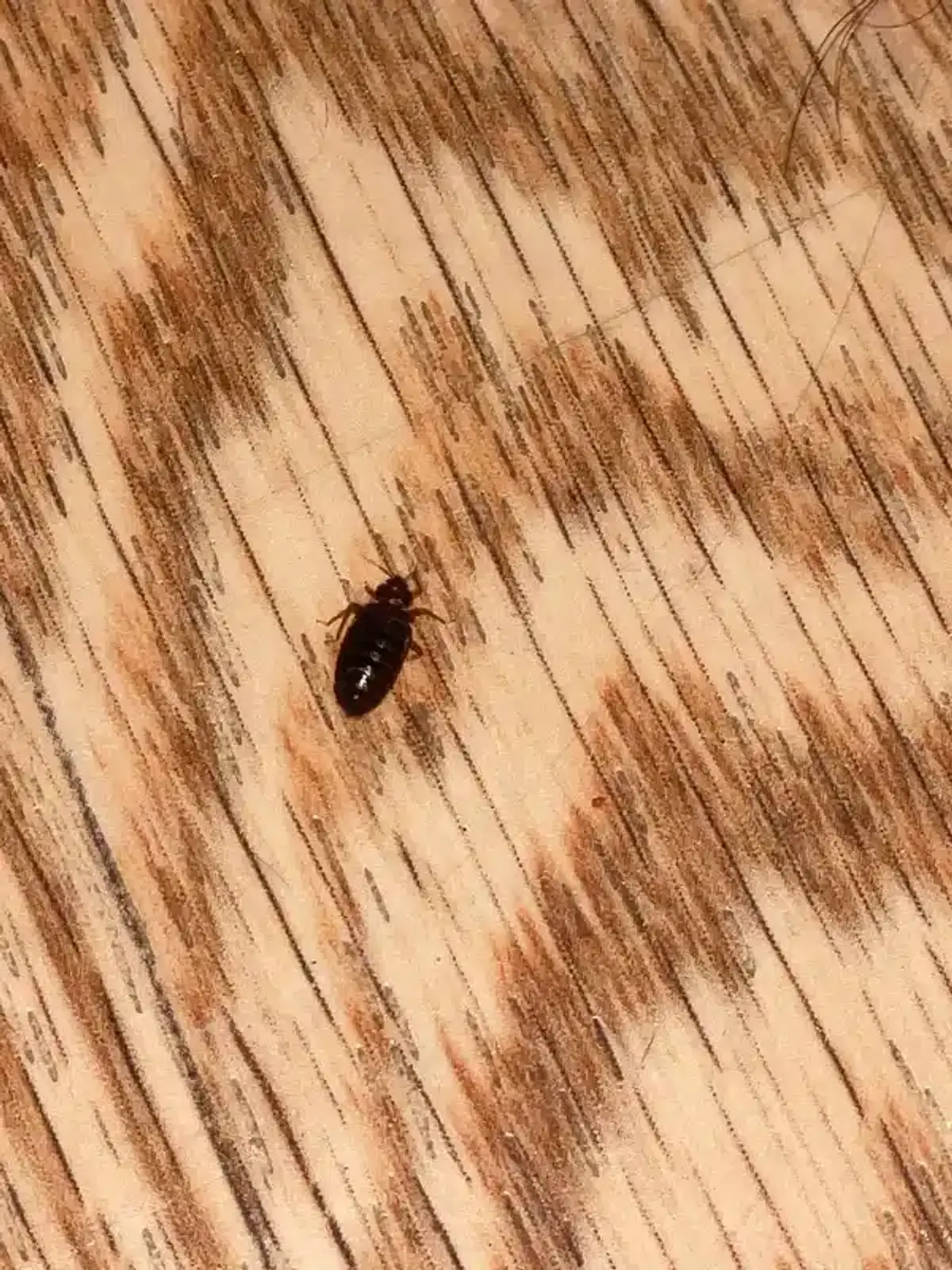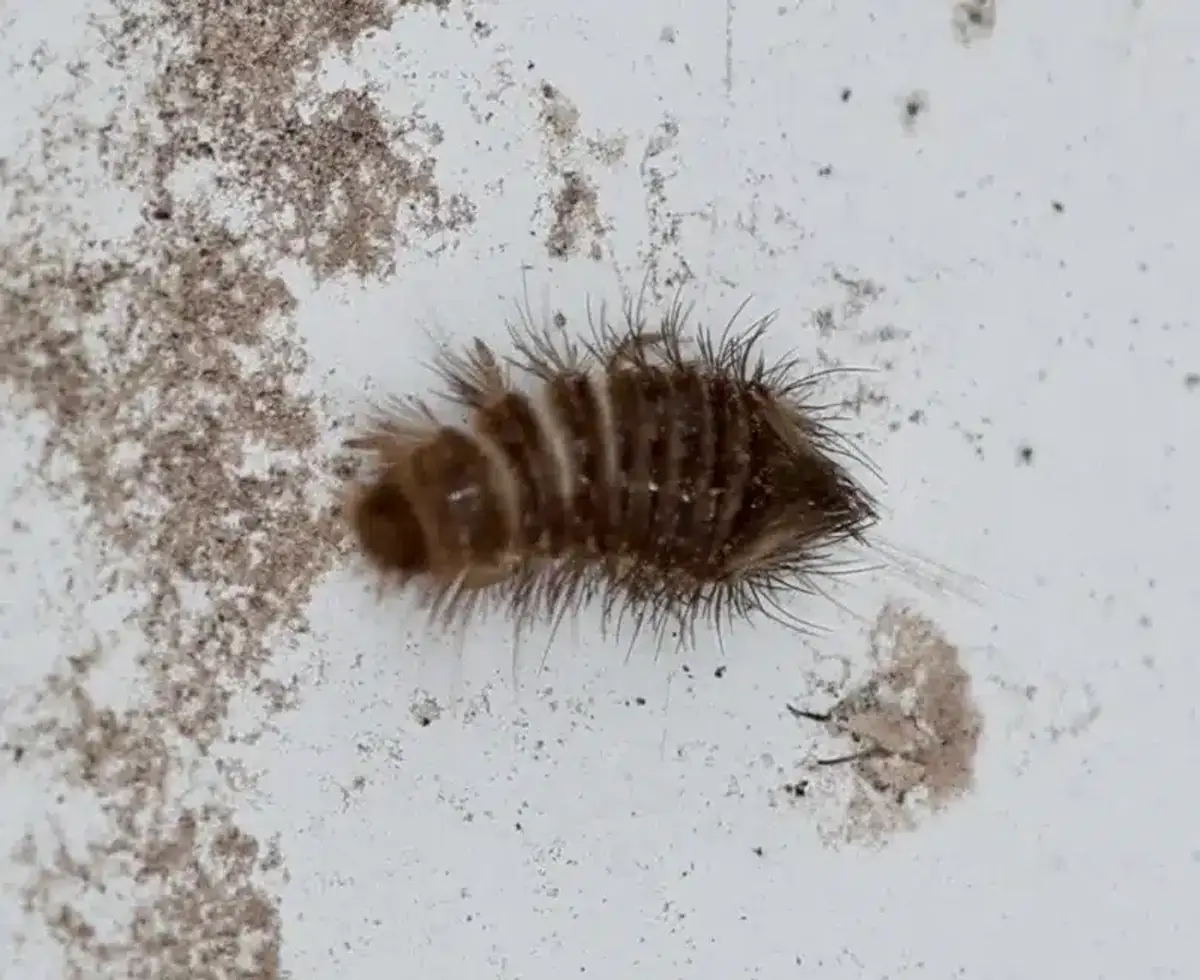If you’ve spotted small bugs in your home or woken up with mysterious bites, you might be wondering whether you’re dealing with carpet beetles or bed bugs. While these two pests are often confused, they’re actually quite different in appearance, behavior, and the problems they cause.
Understanding the difference between carpet beetles vs bed bugs is crucial for proper treatment. Getting the identification wrong can lead to wasted time, money, and frustration. In my four years as a registered technician with our family business that’s been serving the DMV area for over 50 years, I’ve seen countless homeowners struggle with this exact confusion.

How to Tell Carpet Beetles and Bed Bugs Apart
The most reliable way to distinguish between carpet beetles vs bed bugs is by looking at their body shape and color patterns. These physical differences are your first clue to proper identification.
Carpet Beetle Appearance
Carpet beetles have a distinctive round, dome-shaped body that looks similar to a tiny ladybug. Adult carpet beetles measure about 2-4 mm and display mottled patterns of white, yellow, brown, or black scales.
What does the science say?
According to the University of Maryland Extension, carpet beetles have a classic “lady-beetle” shape with colorful, patterned exteriors. This distinctive appearance is key to proper identification, as their dome-shaped body and scale patterns clearly distinguish them from other household pests.
The larvae look completely different from adults. They’re carrot-shaped or teardrop-shaped and covered with brown bristly hairs. These larvae are what actually cause most of the problems in homes.

Bed Bug Appearance
Bed bugs have a completely different look. They’re flat, oval-shaped, and wingless with a reddish-brown color that becomes darker after feeding. Adults measure 1-7 mm in length.
What does the science say?
The CDC describes bed bugs as having a distinctly flattened appearance when unfed, which becomes more pronounced and swollen after blood feeding. This flattened profile allows them to hide in extremely narrow cracks and crevices near sleeping areas.
Unlike carpet beetles, bed bugs maintain the same basic shape throughout their development. Young bed bugs (nymphs) look like smaller, paler versions of adults.
| Carpet Beetles | Bed Bugs | |
|---|---|---|
| Body Shape | Round, dome-shaped | Flat, oval-shaped |
| Coloring | Mottled patterns, colorful | Solid reddish-brown |
| Do They Bite? | No - cause skin irritation | Yes - feed on blood |
| Location | Throughout entire home | Near sleeping areas only |
| Primary Damage | Holes in natural fabrics | Bites and blood stains |

Bed Bug vs Carpet Beetle Bite Patterns and Skin Reactions
One of the biggest sources of confusion when comparing carpet beetles vs bed bugs involves the skin reactions they cause. However, these reactions are actually quite different once you understand what’s happening.
Bed Bug Bites
Bed bugs are blood-feeding insects that bite humans during sleep. Their bites typically appear in distinctive patterns — often called “breakfast, lunch, and dinner” because they form straight lines or clusters on exposed skin. These bites usually show up on arms, shoulders, neck, and face.
The bites themselves are painless when they occur, but develop into itchy, red welts hours later. Because bed bugs probe along clothing edges, you’ll often see neat rows of bites following the line where pajamas or sheets touched your skin.
Carpet Beetle “Bites”
The reaction from carpet beetle larvae tends to be more scattered and appears on areas where clothing has been in contact with skin. The rash might be bumpy, blistery, or hive-like, and it’s caused by contact with the larvae’s irritating hairs, not from being bitten.

Where These Pests Hide in Your Home
Location is another key factor in the carpet beetles vs bed bugs comparison. These pests prefer completely different areas of your home, which can help with identification.
Bed Bug Hiding Spots
Bed bugs are creatures of habit that stay close to their food source — you. They concentrate almost exclusively in sleeping areas, hiding in mattress seams, box springs, headboards, and bed frames. You might also find them in nightstands, picture frames, and curtains near beds.
The closer to your bed, the more likely you are to find bed bugs. They rarely venture far from sleeping areas unless the population becomes very large.
Carpet Beetle Locations
Carpet beetles spread throughout the entire home. Adult beetles are often found near windows (they’re attracted to light), while larvae prefer dark, undisturbed areas like:
- Closets with stored clothing
- Under furniture
- Along carpet edges
- Inside floor vents
- Attics and basements
- Areas with pet hair accumulation
Basically, anywhere there are natural fibers or organic materials, you might find carpet beetle larvae.
Signs of Carpet Beetle vs Bed Bug Infestation
When trying to identify carpet beetles vs bed bugs, the evidence they leave behind tells a clear story about which pest you’re dealing with.
Bed Bug Evidence
Bed bugs leave several telltale signs of their presence:
- Blood spots on sheets from crushed bugs
- Dark or rust-colored stains from fecal spotting
- Sweet, musty odor in heavily infested rooms
- Translucent shed skins near hiding places

Carpet Beetle Evidence
Carpet beetles leave different clues:
- Round, patterned adult beetles near windows
- Bristly, cigar-shaped larval skins in storage areas
- Irregular holes in natural fabrics like wool sweaters
- Damage to stored items containing animal fibers
The fabric damage is particularly telling — bed bugs don’t eat your belongings, but carpet beetle larvae will create small, irregular holes in wool, silk, and other natural materials.

Feeding Habits and Activity Patterns
Understanding what these pests eat and when they’re active helps clarify the carpet beetles vs bed bugs comparison.
What Bed Bugs Eat
Bed bugs are obligate blood feeders, meaning they only consume human and animal blood. They’re most active between 1-5 a.m. when their hosts are in deep sleep.
What does the science say?
According to the EPA, bed bugs can survive months without feeding but will actively seek blood meals when hosts are available. This remarkable survival ability allows infestations to persist even in vacant buildings, making early detection and treatment critical for effective control.
What Carpet Beetles Eat
Adult carpet beetles feed on nectar and pollen outdoors, while larvae consume keratin and chitin-based materials indoors.
What does the science say?
The Ohio State University Extension notes that carpet beetle larvae feed on wool, silk, fur, feathers, dead insects, and sometimes grain-based foods. This protein-rich diet explains why they’re attracted to natural fibers and why damage typically occurs in storage areas containing these materials.
Additionally, carpet beetle adults are day-active and attracted to light, which is why you often see them flying around windows. Larvae wander randomly through your home, unlike bed bugs that follow specific movement patterns toward sleeping areas.
Carpet Beetle vs Bed Bug Treatment Approaches
The treatment for carpet beetles vs bed bugs requires completely different strategies, which is why proper identification is so important.
Treating Bed Bugs
Bed bug treatment focuses on sleeping areas and requires an integrated approach. It’s worth noting that our family business doesn’t treat bed bugs, but homeowners dealing with bed bugs typically need:
- High-heat treatment (118°F for 70+ minutes)
- Professional-grade steam treatment
- Specialized residual insecticides
- Mattress encasements
- Extensive preparation and follow-up
Bed bug treatment is labor-intensive and often requires multiple visits from specialists.
Treating Carpet Beetles
Carpet beetle control emphasizes sanitation and source removal:
- Deep vacuuming of carpet edges, vents, and storage areas
- Laundering or dry-cleaning affected fabrics
- Removing bird nests and organic debris from attics
- Targeted insecticide applications to larval hiding spots
- Exclusion measures like repairing screens
Our registered technicians can handle carpet beetle treatments as part of comprehensive pest control plans. The approach is typically less disruptive than bed bug treatment because it doesn’t require treating sleeping areas.
Essential Carpet Beetle Prevention Steps
- Regular Vacuuming: Focus on carpet edges, baseboards, closets, and areas where pet hair accumulates
- Proper Storage: Keep woolens and natural fabrics in sealed containers or cedar-lined chests
- Source Removal: Check for and remove bird nests, dead insects, or organic debris in attics and crawl spaces
- Fabric Care: Regularly clean and inspect stored clothing, especially items not worn frequently
How to Tell if You Have Bed Bugs or Carpet Beetles
Knowing how to inspect for carpet beetles vs bed bugs can help you determine which pest you’re dealing with before calling professionals.
Inspecting for Bed Bugs
Focus your bed bug inspection on sleeping areas. Use a flashlight to check:
- Mattress seams and tufts
- Box spring corners
- Headboard attachment points
- Screw holes in bed frames
- Nightstand drawers
Look for live bugs, shed skins, blood spots, or dark staining. In the DMV area, multi-family housing often requires checking hallways and shared walls for satellite infestations.
Inspecting for Carpet Beetles
Carpet beetle inspection covers more areas throughout the home:
- Lift carpet edges with pliers
- Check stored woolens in closets
- Examine HVAC registers for larvae
- Inspect attic insulation beneath bird nests
- Look for adult beetles near windows
Vacuum sampling with a lint roller can help collect specimens for identification. Focus on areas where pet hair, lint, or organic materials accumulate.
Why Correct Identification Matters
Getting the carpet beetles vs bed bugs identification wrong leads to wasted treatments and continued problems. I’ve seen homeowners spend hundreds of dollars on the wrong approach because they misidentified their pest.
Misdiagnosis creates several issues:
- Bed bug protocols are expensive and labor-intensive
- Carpet beetle treatments fail if you assume they’re blood-feeding
- Wrong treatments can scatter pests to new areas
- Allergic reactions continue if larvae aren’t properly addressed
The key decision factors are body shape (round vs. flat), location (throughout home vs. bedrooms), and evidence (fabric damage vs. blood spots). When in doubt, it’s worth having a professional identification before starting treatment.
Here in the DMV area, our humid summers create perfect conditions for both pests in different ways. High humidity supports carpet beetle larval development in attics and closets, while urban areas like DC face significant bed bug pressure in multi-family housing.
Getting Professional Pest Control Help
While homeowners can often manage carpet beetle problems with thorough cleaning and targeted treatments, proper identification is always the first step. Our registered technicians have the experience to quickly distinguish between these pests and recommend the most effective approach.
If you’re dealing with what appears to be carpet beetles, our comprehensive pest control plans can address the issue along with other seasonal pests. We use products that have passed through our internal research team - materials we’d feel comfortable using in our own homes.
For bed bug concerns, we can help with identification and refer you to specialists who focus specifically on blood-feeding pest treatments. Getting the right identification from the start saves time, money, and frustration down the road.
Understanding the differences between carpet beetles vs bed bugs is essential for effective pest management. Whether you’re dealing with fabric-damaging larvae or blood-feeding insects, proper identification leads to targeted solutions that actually work.
If you’re experiencing pest issues and need help with identification or treatment, our registered technicians are here to help. Call us at 703-683-2000 to speak directly with a licensed professional, or email us at info@bettertermite.com for expert guidance on your specific situation.
Frequently Asked Questions
How can I tell if I have carpet beetles vs bed bugs without seeing the actual insects?
+
Look at the location of problems and type of damage. Bed bugs leave blood spots and dark staining near sleeping areas, while carpet beetles create irregular holes in natural fabrics throughout the home. Bed bug issues concentrate in bedrooms, but carpet beetle problems appear in closets, storage areas, and anywhere natural fibers are present.
Do carpet beetles bite like bed bugs?
+
No, carpet beetles don't bite at all. The skin reactions people get from carpet beetles come from contact with larval hairs that cause allergic dermatitis. Bed bugs actually bite and feed on blood, creating distinctive bite patterns in lines or clusters on exposed skin.
Where do carpet beetles vs bed bugs typically hide in homes?
+
Bed bugs hide almost exclusively in sleeping areas - mattress seams, bed frames, and nearby furniture. Carpet beetles spread throughout the home, with adults near windows and larvae in dark areas like closets, under furniture, along carpet edges, and in storage spaces with natural materials.
What time of day are carpet beetles vs bed bugs most active?
+
Bed bugs are nocturnal and most active between 1-5 a.m. when they feed on sleeping hosts. Carpet beetle adults are day-active and attracted to light, which is why you see them flying around windows. Carpet beetle larvae move randomly throughout the day in dark, undisturbed areas.
Can carpet beetles and bed bugs be treated the same way?
+
No, they require completely different treatment approaches. Bed bug treatment focuses on sleeping areas with heat, steam, and specialized insecticides. Carpet beetle control emphasizes sanitation, deep vacuuming, laundering affected items, and treating larval hiding spots throughout the home.
What damage do carpet beetles cause compared to bed bugs?
+
Carpet beetle larvae eat natural fibers, creating irregular holes in wool clothing, rugs, and other materials containing animal fibers. Bed bugs don't damage belongings - they only feed on blood and leave staining from their fecal matter on bedding and nearby surfaces.
How quickly do carpet beetles vs bed bugs reproduce?
+
Bed bugs can lay 5-7 eggs per week with females producing over 500 eggs in their lifetime. Development is fastest around 80°F. Carpet beetles have a different lifecycle where larvae can develop for 3 months to 2 years indoors, while adults are short-lived and mainly reproduce outdoors.
What should I do if I'm not sure whether I have carpet beetles or bed bugs?
+
Start by
With five years of hands-on experience in the pest control industry, George Schulz is a registered technician with the Virginia Pest Management Association and a proud third-generation professional in a family business that's been protecting homes for over 57 years. He manages and trains a team of service pros while also leading internal research efforts—recently spearheading a deep-dive review of thousands of documents on pest control materials to hand-pick the most kid and pet friendly, most effective solutions tailored specifically for homes in the DC metro area.
